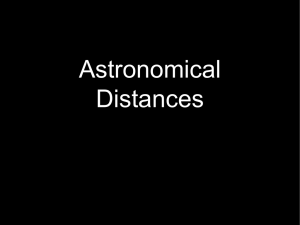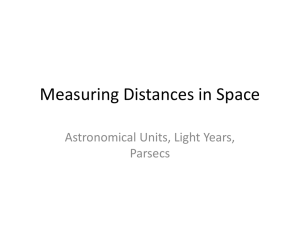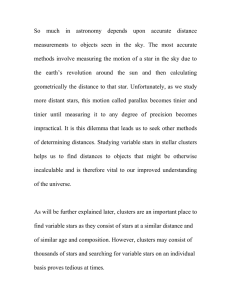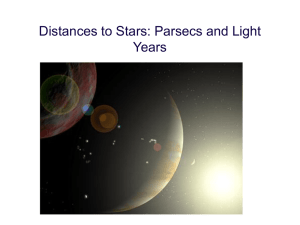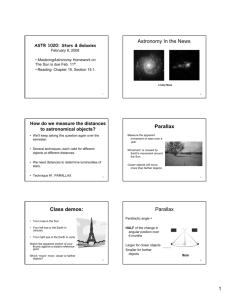The Stars
advertisement
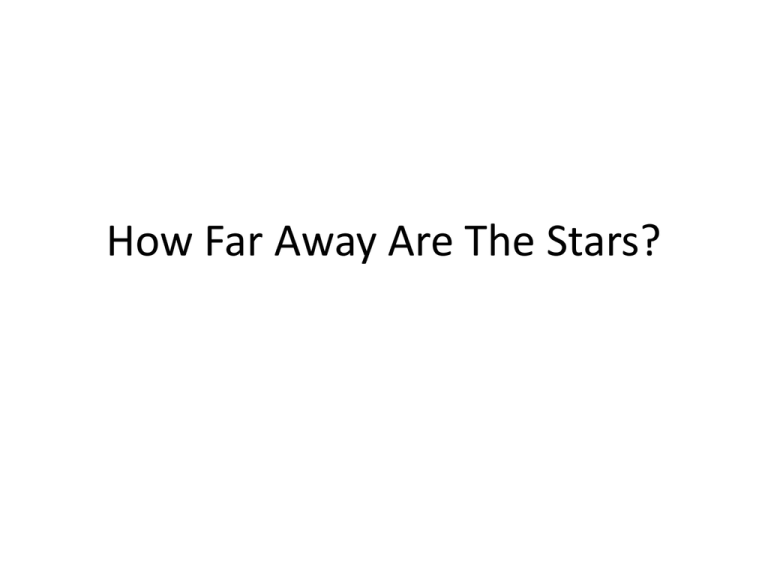
How Far Away Are The Stars? Distances in the Solar System • Kepler’s Third Law relates period and distance • Defines a relative distance scale • One accurate distance determines everything The Streetlight Analogy: What can the prisoner learn about the outside world? Parallax • Nearby Lights Appear to Change Position as the Observer Moves • Can Triangulate to get distance • Can determine true brightness of lights Parallax and the Distances of Stars • Stars appear identical all over Earth • They do show slight parallax shift from opposite sides of Earth’s orbit Parallax: pre-1997 • Parallax is tiny - was once used as argument against motion of the Earth • One second of arc = size of a quarter at 5 km (3 mi.) • Parallax angle of nearest star (4.3 l.y.) is 0.75” • Accuracy limited by Earth’s atmosphere • Fairly accurate to 30-40 l.y., rough to 100 Hipparcos • Named for ancient Greek astronomer who catalogued the stars • High Precision Parallax Collecting System • Launched by European Space Agency, 1989 • Data Collection 1989-1993 • Data Analysis 1993-1997 The Hipparcos Data • 118,218 stars measured: parallax and motion • 22,396 accurate to 10% - a 20-fold improvement • Stars out to 200-300 l.y. are known to within 10% • 30,000 more accurate to 20% • All pre-Hipparcos distance data is obsolete GAIA: the Next Generation • To be placed in Earth-Sun L2 point • Measure a billion stars out to 100,000 l.y.1% of entire galaxy • Transmit 1 Mb every 8 seconds for five years • Accuracy of five micro-seconds (width of a human hair at 2,500 miles) • Data could be available by 2020 Beyond Parallax • More Distant Lights Show Little Parallax • We know how much light nearby lights emit • Can use this to estimate distance of faraway lights • In nearby towns, lights of known type and brightness can be observed • Use brightness to estimate distance • We know how much light a town emits per block • Can estimate the distance of towns even when individual lights cannot be seen • Once we have a good idea how big and bright a typical city is, we can estimate the distance to faraway cities • Nearby clusters of cities allow us to gather statistics • Statistics can estimate distances to faraway clusters of cities • At these distances, some small cities can no longer even be seen. Disasters • Sometimes a big fire will outshine the rest of the city • Distant fires can be used as distance estimators • Sometimes a fire is visible even if the city is too faint to see The Cosmic Distance Scale • Makes use of different indicators for different distances • Each increase in distance builds on previous distances • Faraway distances are only as accurate as nearer distances Distances in our Galaxy • Parallax (to 300+ l.y. with Hipparcos) • Spectroscopic Parallax (Brightness of stars of known types and absolute brightness) • Moving Cluster Method – Radial motions of stars from Doppler Effect – Transverse motions measured directly – Assume velocity distribution uniform Spectroscopic Parallax Variable Stars • Henrietta Leavitt, 1917 • Measured Magellanic Cloud stars - a lot in a small space • Unexpected discovery- some variables have uniform properties • Magellanic Cloud stars all about same distance away (170,000 l.y.) Variable Stars as Yardsticks • RR Lyrae Stars – Have distinctive light variation curve – All about 100 times as luminous as Sun • Cepheid Variables – The brighter, the longer the period – Think of a bell ringing Extragalactic Yardsticks (“Standard Candles”) • Cepheids (Governed specifications for Hubble Space Telescope) • Supernovae • Brightest Galaxy in Cluster • Hubble Parameter (25 km/sec/m.l.y. implies age of universe = 12 billion years)
